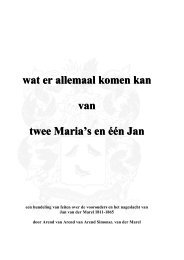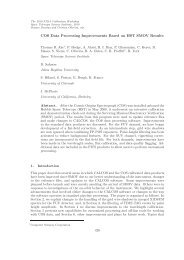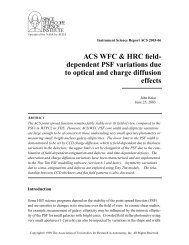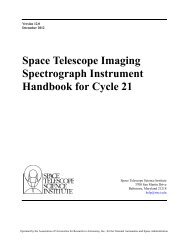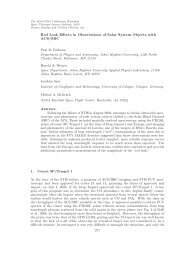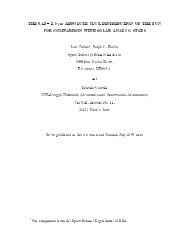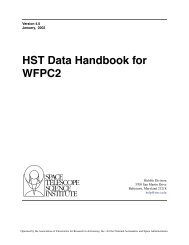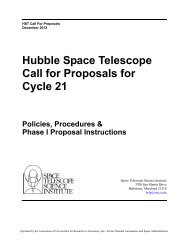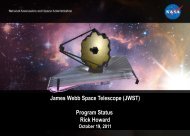STScI Annual Report 2002: A Living Mission
STScI Annual Report 2002: A Living Mission
STScI Annual Report 2002: A Living Mission
You also want an ePaper? Increase the reach of your titles
YUMPU automatically turns print PDFs into web optimized ePapers that Google loves.
profiles<br />
Bonnie Eisenhamer<br />
Bonnie Eisenhamer joined the Institute in<br />
1996 as Education Evaluation Specialist for<br />
the Office of Public Outreach [OPO] and is<br />
currently head of the Formal Education<br />
Group for OPO.<br />
Bonnie was born and raised in Saugerties, N.Y., a<br />
small, rural, one-streetlight town. The town’s only<br />
claim to fame is that it is eight miles down the road<br />
from Woodstock, home of the famous rock music<br />
festival. But it was in Saugerties that Bonnie learned<br />
the importance of helping people by volunteering in<br />
community projects. She was especially interested in<br />
how people communicated and processed information.<br />
When performing her volunteer work, Bonnie always<br />
displayed her sense of humor. In fact, her high school<br />
senior class voted her the “most humorous person,”<br />
although her parents probably would have preferred<br />
“most likely to succeed.” Nonetheless, family and<br />
friends still look forward to her pranks.<br />
Realizing that becoming a comedian would not be a<br />
good career move, Bonnie instead decided to build a<br />
career around helping people succeed through learning.<br />
Bonnie headed off to much warmer climates to pursue<br />
her career. She completed her undergraduate studies,<br />
earning a dual degree in education and psychology at<br />
Chaminade University in Hawaii. Bonnie received her<br />
M.S. degree in clinical psychology at Loyola Marymount<br />
University in California and her M.Ed. degree in<br />
educational psychology at the University of Arizona.<br />
The New York native developed an interest in astronomy<br />
while studying in sunny Arizona, where she met an<br />
astronomy student named Jon Eisenhamer, who was<br />
at Steward Observatory. Bonnie did not know much<br />
about astronomy; she had never even seen a backyard<br />
telescope. Nonetheless, Jon invited her to view the<br />
sky through one of Steward’s large telescopes. Bonnie<br />
never forgot that experience, because, for the first<br />
time, she saw the rings of Saturn. Gazing at those<br />
rings, she became enchanted with the beauty of<br />
space. She also was surprised at what she could<br />
14 new manager profile<br />
continued on page 57<br />
Scientific Visualizations<br />
— Frank Summers<br />
IN <strong>2002</strong>, THE OFFICE OF PUBLIC OUTREACH (OPO) BROKE<br />
NEW GROUND IN OUR ABILITY TO COMMUNICATE THE<br />
WONDERS OF ASTRONOMY VISUALLY. While we continued our<br />
traditionally strong development of scientific visualizations for press releases<br />
and the Internet, we opened two new avenues. The Visualization Wall project<br />
created an unprecedented ability to view high-resolution imagery at the<br />
Institute, and our distribution of visualizations to planetariums provided highquality,<br />
scientifically accurate imagery to those important external venues.<br />
OPO’s Astronomy Visualization Lab has long provided a wide range of<br />
extraordinary visuals in support of our press releases. In <strong>2002</strong>, our scientific<br />
visualizations illustrated astronomical scenes ranging from icy worlds at the<br />
edge of the Solar System to the birth of stars at the early stages of the universe.<br />
In January, a visualization of the ‘fireworks’ of stellar birth some 12<br />
to 13 billion years ago illustrated the news of Hubble’s finding rapid star<br />
formation at that epoch. In April, a visualization showing the enormous<br />
changes a star goes through during its lifetime illustrated a press release<br />
on the oldest stars in the Milky Way. In September, an intriguing animation<br />
of the distorted view near a black hole illustrated a release on black holes<br />
in globular clusters. Visualizations, illustrations, and artist’s conceptions<br />
richly illustrated two press releases on new discoveries in the Solar<br />
System’s Kuiper Belt.<br />
On the Internet side, we used a scientific visualization to experiment<br />
with higher bandwidth content delivery. Our Striking Encounters project<br />
explained the wholesale destruction and distortion that occurs when two<br />
galaxies collide. It used a visualization of a galaxy collision as the centerpiece,<br />
packaged with images of observed galaxy collisions, narration, and<br />
music. Striking Encounters provides a complete story in a seamless,<br />
streaming download. Currently, bandwidth limitations constrain our ability<br />
to provide such visualizations to the public over the Internet. Nevertheless,<br />
this project ventured ‘outside the box’ to give us a glimpse of future possibilities.<br />
Our Visualization Wall project explores the impact of displaying highresolution<br />
images, such as those from the Advanced Camera for Surveys<br />
(ACS), at full detail. An ACS Wide Field Camera image has 16 million pixels,<br />
while the average computer screen has only 1 million. We assembled 16 flat<br />
panel computer screens in a 4 x 4 array to create a 20 million pixel display<br />
measuring over six feet diagonally. We drive this display with a cluster of<br />
17 Linux computers—one for each screen plus a master, control computer.<br />
This cluster also offers significant horsepower for scientific analysis and<br />
computation. The results are stunning. The Visualization Wall allows one to<br />
stand back and get an overview or walk up to it and examine details—one<br />
can see both the forest and the trees.



